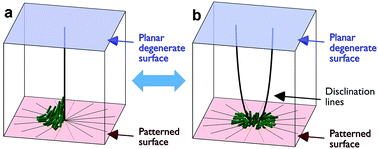Transition from escaped to decomposed nematic defects, and vice versa†
Abstract
An escaped radial director profile in a nematic liquid crystal cell can be transformed into a pair of strength m = +1/2 surface defects (and their associated disclination lines) at a threshold electric field. Analogously, a half-integer defect pair can be transformed at a threshold electric field into a director profile that escapes into the third dimension. These transitions were demonstrated experimentally and numerically, and are discussed in terms of topologically discontinuous and continuous pathways that connect the two states. Additionally, we note that the pair of disclination lines associated with the m = +1/2 surface defects were observed to co-rotate around a common point for a sufficiently large electric field at a sufficiently low frequency.



 Please wait while we load your content...
Please wait while we load your content...
